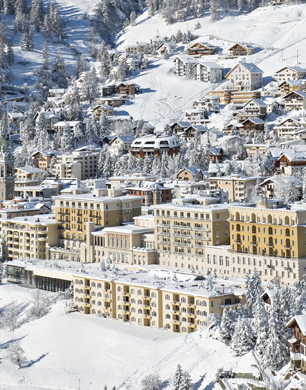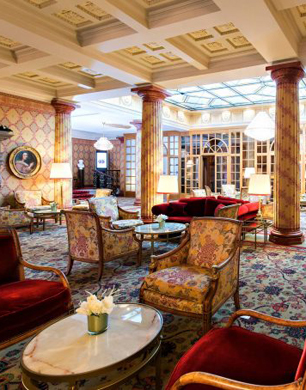 The birthplace of winter tourism, St Moritz remains the glitziest resort in the Swiss Alps. Where to stay? The town’s very first hotel of course – The Kulm.
The birthplace of winter tourism, St Moritz remains the glitziest resort in the Swiss Alps. Where to stay? The town’s very first hotel of course – The Kulm.
It was in the autumn of 1864 that the seed of winter tourism was planted. At this time, the Alps were a popular summer destination, where the wealthy elite from across Europe would visit to enjoy the crisp alpine air and glorious countryside. Johannes Badrutt, one of the continent’s great early hoteliers, sat by a fire in the hotel that would one day become the Kulm with some of his most cherished English guests. He mentioned to them that he had been spending his winters in the surprisingly mild mountains, where the skies were blue, the sun shone brightly, and everything was coated in a beautiful blanket of white. His guests scoffed at the idea; they knew what winter was like in a cold climate, and had no interest in visiting somewhere even colder. Legend has it that Badrutt made with them a bet – they would return in December, and spend their Christmas in St Moritz. If they didn’t enjoy themselves, he would pay for everything. Enticed by the promise of an escape from wet and windy London, they agreed. It was no surprise to Badrutt that he won the bet, and his guests ended up staying until Easter.
Today, much like 150 years ago, St Moritz is a resort of split personalities. From late November the international jet set start descending to ski, spa, and shop. In summer, the town becomes a hiker’s paradise with the whole of the Engadine Valley to explore. Whenever you visit, St Moritz provides high end glamour and outstanding natural beauty in spades. Where to stay? Johannes Badrutt’s first hotel of course – The Kulm
Stay
The Kulm stands today as a five star deluxe hotel, recently named Gault Millau Swiss Hotel of the Year 2018, complete with 170 individually designed bedrooms and suites, seven restaurants, several bars and lounges, a full service spa, and a Norman Foster designed country club equipped with a jaw dropping natural ice rink.
The hotel’s name comes from a Swiss word that refers to the highest point in a location. Although there are now several hotels built higher into the valley, the Kulm retains a good location in the centre of town, just a stone’s throw from the world class shopping.
From the moment you step inside, the mood is set. An entrance foyer of wood panelled walls and colossal ceilings sweeps through to a sumptuous golden lobby with fireplaces and plush French furniture. The people watching here is on another level – from Eastern oligarchs to immaculate Swiss grandmothers swathed in fur, the hotel’s guests are almost as enthralling as the alpine views beyond the lobby’s grand windows.
The 170 rooms and suites are divided up into numerous categories and styles. Most are alpine-inspired, with either an old-school or modern finish. The more contemporary rooms are a fairly recent addition to the hotel by celebrated designer Pierre-Yves Rochon. His interiors update the Kulm’s original look while retaining an alpine sensibility. Think butter soft taupe leathers, mirrored surfaces, and polished wood veneer.
We stayed in one of the traditionally decorated Junior Suites finished with oak walls, agricultural oil paintings, and lots of luxurious brocaded fabric. The bathroom was spacious and entirely marble, with a deep sinking tub, separate shower, double vanities, and Asprey toiletries.
Eat
The Kulm has some serious foodie credentials. With seven restaurants offering everything from white gloved, silver service dining to the most casual of Italian pizzerias, there is something to suit every occasion and preference.
The Grand Restaurant is the most formal option, and occupies the impressive ballroom – also the location of the hotel’s lavish breakfast. In the evening the restaurant serves a six course set menu of classical French cuisine. We tried delicacies such as scallops with caviar, seabream en Papilote, stone baked quail, and Grand Marnier parfait.
As a hotel that closes off-season the Kulm doesn’t have a permanent Michelin starred restaurant, and instead invites lauded chefs to perform cyclical residences while it’s open. They occupy an intimate space named The K. The most recent chef to cook here was Tim Raue, whose Asian inspired Berlin restaurant currently holds two stars
The Sunny Bar, famed for its association with the Cresta runs, creates exotic Peruvian small plates under the guidance of Chef Claudia Canessa. A rustic pizzeria nods to St Moritz’s proximity to the Italian border, and is a firm local favourite. Chesa al Parc and the Bob Restaurant both serve traditional Swiss cuisine from cheese fondue to potato rosti.
Relax
One of the Kulm’s star attractions is its monumental spa. A modern extension of glass and stone forged into the side of valley, it offers unparalleled indoor views of the Engadine Valley and 2000 metres of relaxation space. The jewel in the spa’s crown is its outdoor hydrotherapy pool; the combination of steaming hot water and cold alpine air are sure to put a spring in any guest’s step.
There’s also a large indoor swimming pool, several sauna and steam rooms, a relaxation room fitted with water beds, and several treatment rooms where an array of body treatments, massages, and facials are offered by charming and well-trained therapists.
Do
Whether visiting in the winter or summer seasons, there is always something wonderful to do in St Moritz.
When the weather is colder most guests come for the fantastic skiing. But other winter sports are also popular here, in particular the Cresta runs for which St Moritz is famous. Snowboarding has gained considerable popularity, and cross country skiing remains a favourite among those with stamina and endurance. The shopping is amongst the best in Europe, with every major European label represented from Chanel and Dior, to Loro Piana and Hermès. And of course, the hotel’s very own ice rink at the Kulm Country Club will delight guests both young and old.
After a brief closure, the hotel reopens in the summer months and guests come for hiking, mountain biking, climbing, mountaineering, exquisite walking paths, and lake activities. And more of that fabulous shopping, obviously.
There are several ways to get to St. Moritz, including by private jet, helicopter, or car. Most affordable is to fly into Zurich and travel on by train. The Swiss Transfer Ticket covers a round trip from airport to resort and is priced from £112. For more information on visiting St. Moritz and Switzerland see www.MySwitzerland.com


